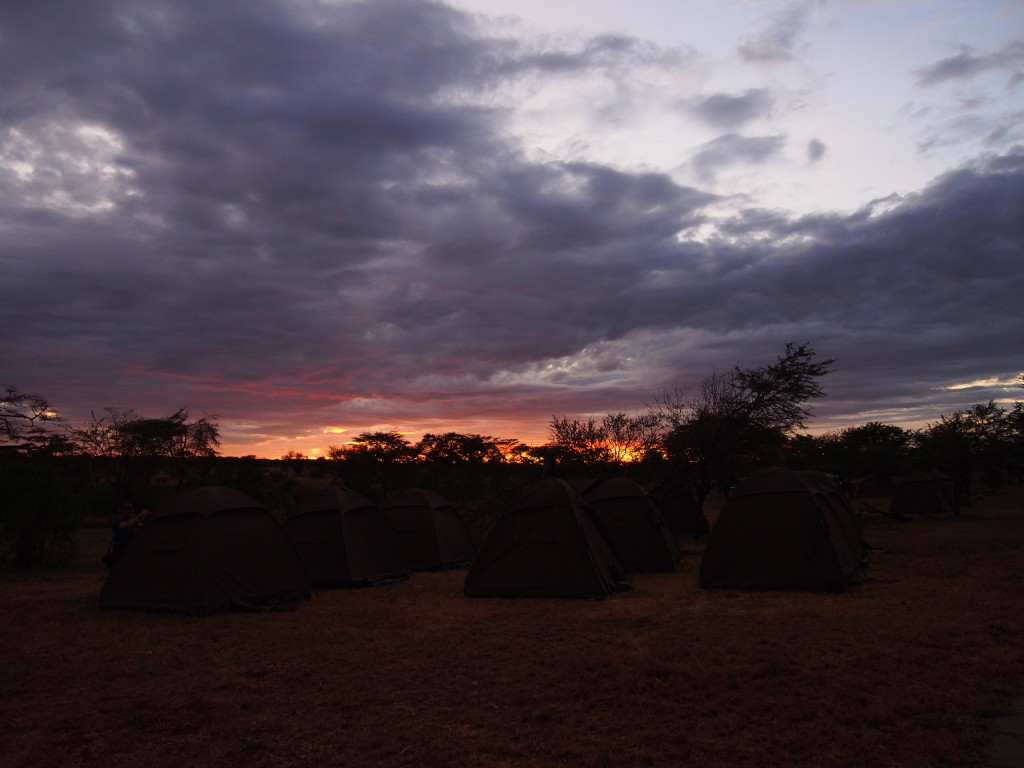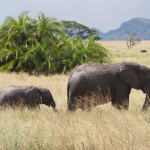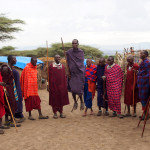I flew into Nairobi, Kenya to join a 3 week overlanding tour of East Africa with the tour operator Nomad Tours South Africa, booked through Peri Peri Reizen. The guides Nika, TK and Evans introduced themselves and set a friendly and fun tone for the tour. They made introductions and then bundled us into our overland truck (the truck is named Morrison) and set off for Arusha in Tanzania. Arusha is the gateway to Serengeti National Park, Ngorongoro Crater & Mount Kilimanjaro. We spent two nights in Arusha, one before and one after our jeep safari.
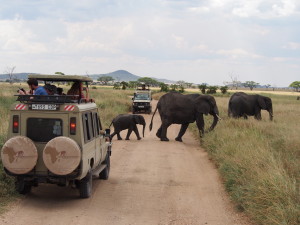 Run by local operator Tanzania Experiences, we headed off to the Serengeti National Park and Ngorongoro Crater for a four day/three night jeep safari. The jeep safari was an additional excursion on top of the tour and cost approximately USD$560.
Run by local operator Tanzania Experiences, we headed off to the Serengeti National Park and Ngorongoro Crater for a four day/three night jeep safari. The jeep safari was an additional excursion on top of the tour and cost approximately USD$560.
The safari was spent almost entirely in the jeep for two reasons, firstly the distances are huge so there is a great deal of time spent in transit between locations, secondly the parks are full of amazing, but very dangerous animals, so seeing them is done in the form of a game drive.
We did three game drives in the Serengeti National Park and one in the Ngorongoro Crater.
Serengeti National Park
The name ‘Serengeti’ means Endless Plain and accurately reflects the size, 14762 square kilometres, and appearance of the park. It is the second largest national park in Tanzania. Despite is being called a plain, the landscape is broken up with rivers, lakes, hills, rocky outcropping a and trees. This can make it challenging for spotting animals, but does provide them a varied environment with many shady areas under which they can escape the heat of the day.
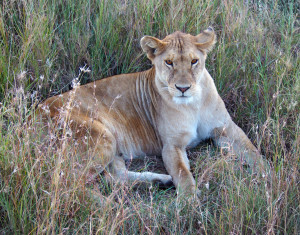 Our driver Rashid was absolutely brilliant on spotting wildlife and communicating with other drivers on where to find certain animals. He was very knowledgeable on breeds, facts, and statistics about the animals and shared the information with us in a fun and informative manner, sometimes pop quiz style.
Our driver Rashid was absolutely brilliant on spotting wildlife and communicating with other drivers on where to find certain animals. He was very knowledgeable on breeds, facts, and statistics about the animals and shared the information with us in a fun and informative manner, sometimes pop quiz style.
We were incredibly lucky to see four of “The Big Five” numerous times in the park: Leopards, Elephants, Lions and Buffalo. The fifth animal in the big five is the Rhinoceros, which we saw in the Ngorongoro Crater.
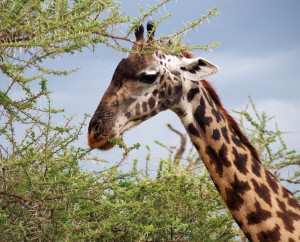 We also saw a Cheetah, Giraffes, Zebra, Topis, Impalas, Thomson Gazelles, Grant’s Gazelles, Wildebeest, Hippopotamus’, Black-backed Jackals, Hyraxes, Hartebeest, Warthogs, Hyena, Baboons, Ostriches and loads of different types of birds.
We also saw a Cheetah, Giraffes, Zebra, Topis, Impalas, Thomson Gazelles, Grant’s Gazelles, Wildebeest, Hippopotamus’, Black-backed Jackals, Hyraxes, Hartebeest, Warthogs, Hyena, Baboons, Ostriches and loads of different types of birds.
The best times to see the animals are in the cooler parts of the day, early morning and late afternoon. Even then many, such as the large cats, are usually found hiding in shady places in tree branches or under trees.
 As you can appreciate with any experience involving wildlife spotting, it is all about luck. I think we were incredibly lucky to have seen all of the animals that we did. Our biggest stroke of luck was in seeing a cheetah, the most solitary and reclusive of all the big cats. The cheetah was hanging out in the shade under a tree. We sat and watched it for some time, it got up and moved to another shady spot and then another. While we didn’t get to see a chase, we were thoroughly grateful to see the cat both sitting, standing and walking. An interesting piece of information about the cheetah – it differs from all the other big cats as it doesn’t climb trees due to the fact that it does by have retractable claws. If it were to climb a tree and get a claw stuck and damaged it would limit its ability to hunt effectively and most likely result in death.
As you can appreciate with any experience involving wildlife spotting, it is all about luck. I think we were incredibly lucky to have seen all of the animals that we did. Our biggest stroke of luck was in seeing a cheetah, the most solitary and reclusive of all the big cats. The cheetah was hanging out in the shade under a tree. We sat and watched it for some time, it got up and moved to another shady spot and then another. While we didn’t get to see a chase, we were thoroughly grateful to see the cat both sitting, standing and walking. An interesting piece of information about the cheetah – it differs from all the other big cats as it doesn’t climb trees due to the fact that it does by have retractable claws. If it were to climb a tree and get a claw stuck and damaged it would limit its ability to hunt effectively and most likely result in death.
Accommodation
Our tour guides put up tents for us in a campsite, Seronera Campsite.
The facilities provided were minimal but sufficient and there was no electricity. I was a little surprised at the lack of protection against the wild here, but I guess that’s part of the thrill of being in a national park in Africa. After dark it was up to you to be vigilant and scan the darkness for eyes with your head torch.
The first night we heard Hyenas, Lions and a Leopard. The second night, even before going to bed, the camp was surrounded by Hyenas – animals which are thankfully scavengers. The first morning we had baboons rummaging through the trash can in the middle of the camp and the second morning buffalo were hanging around the outer edges of the site. These experiences were equal parts terrifying and exciting!
Ngorongoro Crater
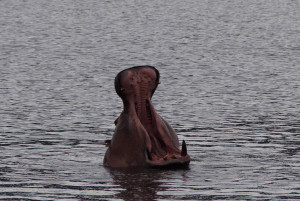 The Ngorongoro Crater is a UNESCO World Heritage listed site, that is a famous natural wonder. The rim to the crater floor varies in height from 400-610metres and is quite a deep descent. The crater floor is 19km wide and covers an area of 264 square kilometres.
The Ngorongoro Crater is a UNESCO World Heritage listed site, that is a famous natural wonder. The rim to the crater floor varies in height from 400-610metres and is quite a deep descent. The crater floor is 19km wide and covers an area of 264 square kilometres.
 A pre-dawn wake up call had us descending into the crater as the sun was rising. The landscape was much flatter, greener and had fewer (almost no) trees, this made animal spotting a little bit easier.
A pre-dawn wake up call had us descending into the crater as the sun was rising. The landscape was much flatter, greener and had fewer (almost no) trees, this made animal spotting a little bit easier.
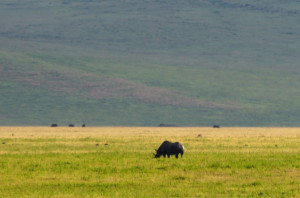 In addition to the animals we saw in the Serengeti, we also saw Black Rhinoceros’, Bat-Eared Foxes, Golden Jackals and Elands on the crater floor.
In addition to the animals we saw in the Serengeti, we also saw Black Rhinoceros’, Bat-Eared Foxes, Golden Jackals and Elands on the crater floor.
The animal that we considered to be the specialty of Ngorongoro was the Black Rhinoceros. It is an animal close to extinction, with a current population estimated at around 400. Of the total population, approximately 15 are resident in the crater, and despite only being able to see them from a huge distance, we were lucky enough to see six of them.
Accommodation
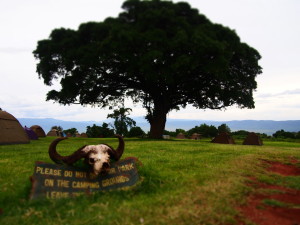 The campsite at Ngorongoro Crater, Simba Campsite, was on the crater rim and had a reasonable view put towards the crater floor. This was a larger campsite than the Serengeti and had better facilities, including electricity, hot showers and armed security patrolling the site.
The campsite at Ngorongoro Crater, Simba Campsite, was on the crater rim and had a reasonable view put towards the crater floor. This was a larger campsite than the Serengeti and had better facilities, including electricity, hot showers and armed security patrolling the site.
Maasai Village
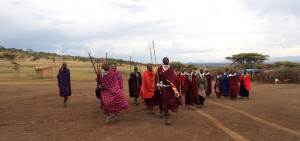 In transit between the Serengeti National Park and the Ngorongoro Crater, we stopped to visit a Maasai Village, for USD$10 per person.
In transit between the Serengeti National Park and the Ngorongoro Crater, we stopped to visit a Maasai Village, for USD$10 per person.
The Maasai of the village welcomed us outside their gates with a traditional welcome ceremony of chanting and dancing/jumping.
Once we were then invited in to the village where the men and women separated and showed us a little more of their traditional dancing/jumping, also inviting us to join in. It was actually really quite fun.
We were then given a tour of the village, including the livestock pen, the school and a home.
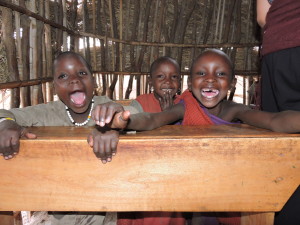 The life of the Maasai centers around their livestock and their village construction reflects this. In the center of the village is a circular pen where livestock are kept overnight. During the day the livestock are herded around the countryside. The houses are all built in a circle around the livestock pen and facing it, but with a four to five meter gap between. The houses are constructed from Acacia trees, cow dung and urine. It’s not the most watertight construction, so when it rains they pull a plastic tarpaulin over each home. The men of the village may have multiple wives, and for each family there is one home (so one man might have a few homes).
The life of the Maasai centers around their livestock and their village construction reflects this. In the center of the village is a circular pen where livestock are kept overnight. During the day the livestock are herded around the countryside. The houses are all built in a circle around the livestock pen and facing it, but with a four to five meter gap between. The houses are constructed from Acacia trees, cow dung and urine. It’s not the most watertight construction, so when it rains they pull a plastic tarpaulin over each home. The men of the village may have multiple wives, and for each family there is one home (so one man might have a few homes).
Interestingly, the school building we visited was outside of both of these circles. On questioning I was told that it is because the school is only used for an hour or two during the day for children who aren’t yet old enough to go to proper school, and that day time is safe.
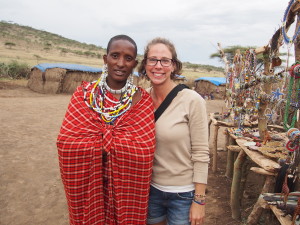 To end the tour we were asked to visit the marketplace of each of the families. Around the circle between the livestock pen and the houses were small ‘shops’ from each family to sell their beaded jewellery and handcrafts. Their prices were exorbitant, but by spending inside their community it is nice to choose products that are handmade by their creator with the knowledge that the money goes directly to the community without a store taking commission. It is a very touristic setup, but nonetheless fascinating. On my way back to the bus a lovely gentleman advised me, with eager eyes, that he had one black wife, but would also like to have a white wife…
To end the tour we were asked to visit the marketplace of each of the families. Around the circle between the livestock pen and the houses were small ‘shops’ from each family to sell their beaded jewellery and handcrafts. Their prices were exorbitant, but by spending inside their community it is nice to choose products that are handmade by their creator with the knowledge that the money goes directly to the community without a store taking commission. It is a very touristic setup, but nonetheless fascinating. On my way back to the bus a lovely gentleman advised me, with eager eyes, that he had one black wife, but would also like to have a white wife…
Toilets
Toilets in East Africa, particularly an overlanding trip, deserve a special mention. You will find three kinds of toilet in East Africa: a normal western toilet, a squat toilet and a bush toilet. Firstly you can’t assume for any of these that there will be toilet paper, so always carry a roll in your backpack.
The Western Toilet
Often, but not always, when you find a western toilet it’s in a tourist destination that’s maybe a bit more up-scale. They often have a toilet seat and are often quite clean.
The Squat Toilet
The squat toilet is pretty common around East Africa. Unfortunately they are often quite dirty and smelly, mostly just because westerners are unfamiliar with how to use them, and finding one that is dirty and smelly is not conducive to wanting to give something new a try. Thought they are much more hygienic than a standard western toilet since you actually don’t touch anything.
The Bush Toilet
The bush toilet can be found literally anywhere and it’s more hygienic than the western or squat toilet. You simply squat behind a bush, tree or even a car. It’s actually rather hilarious when the truck pulls over, everyone gets out and all you can see are girls heads peeking out over the tall grasses on the roadside as everyone squats (you will need to put your modesty aside for this excursion).
The rule of thumb is that any paper you use should be put in the trash can, not thrown on the ground and poop should be buried (personally I’m happy to do a bush wee, but I would personally wait for the nearest western convenience for any pooping)
Medical Advice
First and foremost, consult a travel GP before heading to East Africa. Two things I know as a fact – you must have your Yellow Fever vaccination and take Malaria prevention tablets (and use really good bug spray with a high percentage of DEET). My vaccination record was checked for Yellow Fever at the border when I transited from Kenya to Tanzania.
The last time I checked you also require up to date vaccinations for Typhoid, Hepatitis A, Hepatitis B and Tetanus.

